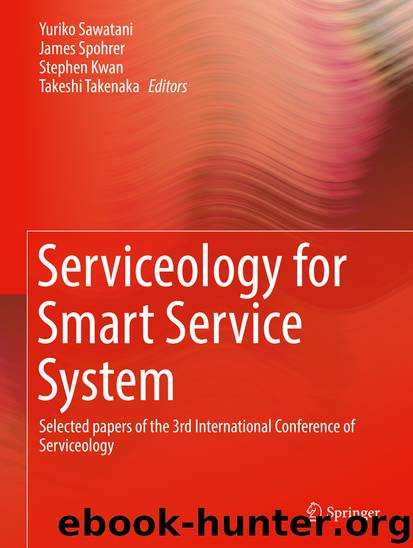Serviceology for Smart Service System by Yuriko Sawatani James Spohrer Stephen Kwan & Takeshi Takenaka

Author:Yuriko Sawatani, James Spohrer, Stephen Kwan & Takeshi Takenaka
Language: eng
Format: epub
Publisher: Springer Japan, Tokyo
Keywords
Customer behaviorRetail serviceConsumer preference
1 Introduction
To increase customer satisfaction in retail settings, it is necessary to provide items and services tailored to the preferences of the consumer. Many shops display their wares according to not only the category of the item but also to characteristics of the item that they feel are linked to consumer values (low price, luxurious, healthy, etc.), with the idea that such displays will assist consumers in identifying the items they wish to purchase. Personal coupon services, which offer specific items to consumers who have been selected on the basis of assumed consumer preferences, are also designed to attract the consumer’s attention.
In order for these consumer-oriented services to succeed, the person in charge of merchandising and service planning needs to understand consumer preference tendencies and which items/services are likely to attract consumers with which tendencies. Preference type analysis is required to help such personnel clarify their understanding of consumer preference and the effect it has on purchase behaviors.
With the current widespread use of point cards and electronic money, large amounts of personal purchase data are being stored by retail companies [1, 2]. These records are expected to help clarify consumer behavior and preferences, and the effective utilization of these data for improving consumer-oriented services is crucial.
The objective with this research is to build a model and accompanying method to assist retailers in obtaining knowledge about consumer preference tendencies and to effectively utilize personal purchase records.
In Sect. 2, related works are briefly discussed, and the problems related to improving human understanding for utilizing personal purchase records are explained. The proposed model and accompanying method to resolve these problems are proposed in Sect. 3, and in Sect. 4 the experiment is described. The results are presented and discussed in Sect. 5 and important conclusions are presented in Sect. 6.
Download
This site does not store any files on its server. We only index and link to content provided by other sites. Please contact the content providers to delete copyright contents if any and email us, we'll remove relevant links or contents immediately.
Hit Refresh by Satya Nadella(9001)
The Compound Effect by Darren Hardy(8742)
Change Your Questions, Change Your Life by Marilee Adams(7573)
Nudge - Improving Decisions about Health, Wealth, and Happiness by Thaler Sunstein(7468)
The Black Swan by Nassim Nicholas Taleb(6953)
Deep Work by Cal Newport(6826)
Daring Greatly by Brene Brown(6374)
Rich Dad Poor Dad by Robert T. Kiyosaki(6324)
Principles: Life and Work by Ray Dalio(6137)
Man-made Catastrophes and Risk Information Concealment by Dmitry Chernov & Didier Sornette(5883)
Playing to Win_ How Strategy Really Works by A.G. Lafley & Roger L. Martin(5782)
Digital Minimalism by Cal Newport;(5593)
Big Magic: Creative Living Beyond Fear by Elizabeth Gilbert(5562)
The Myth of the Strong Leader by Archie Brown(5380)
The Slight Edge by Jeff Olson(5322)
Discipline Equals Freedom by Jocko Willink(5246)
The Motivation Myth by Jeff Haden(5131)
Stone's Rules by Roger Stone(4994)
The Laws of Human Nature by Robert Greene(4932)
